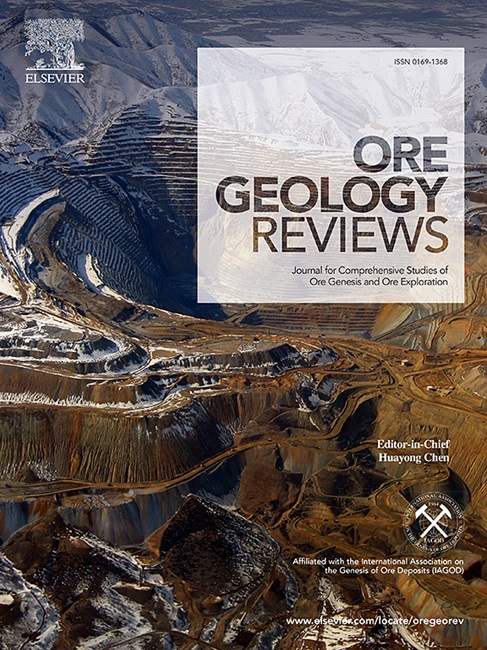Nanoscale study of Fe-Mn micronodules in deep-sea sediment from the Western Pacific Ocean
IF 3.2
2区 地球科学
Q1 GEOLOGY
引用次数: 0
Abstract
This study collected early-stage Fe-Mn micronodules from the seafloor of the Western Pacific and analyzed their structural characteristics and elemental distribution using Scanning Electron Microscopy (SEM), Focused Ion Beam (FIB) and Transmission Electron Microscopy-Energy Dispersive X-ray Spectroscopy (TEM-EDS). The results indicate that the micronodule exhibits stratified growth profiles, including laminated structures, lamellar structures and porous loose layers. Fe and Ti are concentrated in the core region of the micronodule, followed by a clay mineral layer enriched in Al, Mg, Si and K, while the outermost layer is dominated by Mn, forming a dense layer enriched with I and Pb at the edge. The distribution of Fe and Mn within the micronodule shows a clear negative correlation. Further analysis revealed that the main mineral phases in the micronodule (ferrihydrite and montmorillonite), as well as the titanium oxides, manganese oxides and lead iodide located at the edge of the micronodule, all exist as nanoparticles. Ferrihydrite is positively correlated with the enrichment of heavy rare earth elements (HREEs) such as Dy, Tb, Er and Tm, while manganese oxides play a significant role in the selective removal or enrichment of specific light rare earth element (LREE) like Eu, as well as certain HREEs such as Er, Tm and Gd. Additionally, the presence of Ti, clay minerals, I and Pb may have a critical influence on the enrichment of Tm, Er, Gd, Yb, Ho, Ce, Pr, La, Nd, Sm, K and Mg in the regional marine environment. These findings enhance our understanding of the mechanisms governing the occurrence and distribution of rare earth elements (REEs) in Fe-Mn micronodules and highlight the pivotal role of nanoparticles in the early-stage growth and elemental enrichment of micronodules, providing new insights into the genesis and evolution of deep-sea Fe-Mn micronodules.

西太平洋深海沉积物中Fe-Mn微分子的纳米尺度研究
利用扫描电镜(SEM)、聚焦离子束(FIB)和透射电镜-能量色散x射线能谱(TEM-EDS)分析了西太平洋海底早期Fe-Mn微模块的结构特征和元素分布。结果表明,微微球呈现层状结构,包括层状结构、层状结构和多孔疏松层。Fe和Ti富集在微球的核心区域,其次是富含Al、Mg、Si和K的粘土矿物层,而最外层以Mn为主,在边缘形成富集I和Pb的致密层。铁和锰在微球内的分布呈明显的负相关。进一步分析表明,微颗粒中的主要矿物相(水合铁和蒙脱土)以及位于微颗粒边缘的氧化钛、氧化锰和碘化铅均以纳米颗粒的形式存在。水合铁与Dy、Tb、Er、Tm等重稀土元素(hree)的富集呈正相关,而锰氧化物对Eu等特定轻稀土元素(LREE)以及Er、Tm、Gd等特定重稀土元素的选择性去除或富集作用显著。此外,Ti、粘土矿物、I和Pb的存在可能对区域海洋环境中Tm、Er、Gd、Yb、Ho、Ce、Pr、La、Nd、Sm、K和Mg的富集具有重要影响。这些发现增强了我们对Fe-Mn微球中稀土元素的发生和分布机制的认识,突出了纳米颗粒在微球早期生长和元素富集中的关键作用,为研究深海Fe-Mn微球的形成和演化提供了新的思路。
本文章由计算机程序翻译,如有差异,请以英文原文为准。
求助全文
约1分钟内获得全文
求助全文
来源期刊

Ore Geology Reviews
地学-地质学
CiteScore
6.50
自引率
27.30%
发文量
546
审稿时长
22.9 weeks
期刊介绍:
Ore Geology Reviews aims to familiarize all earth scientists with recent advances in a number of interconnected disciplines related to the study of, and search for, ore deposits. The reviews range from brief to longer contributions, but the journal preferentially publishes manuscripts that fill the niche between the commonly shorter journal articles and the comprehensive book coverages, and thus has a special appeal to many authors and readers.
 求助内容:
求助内容: 应助结果提醒方式:
应助结果提醒方式:


